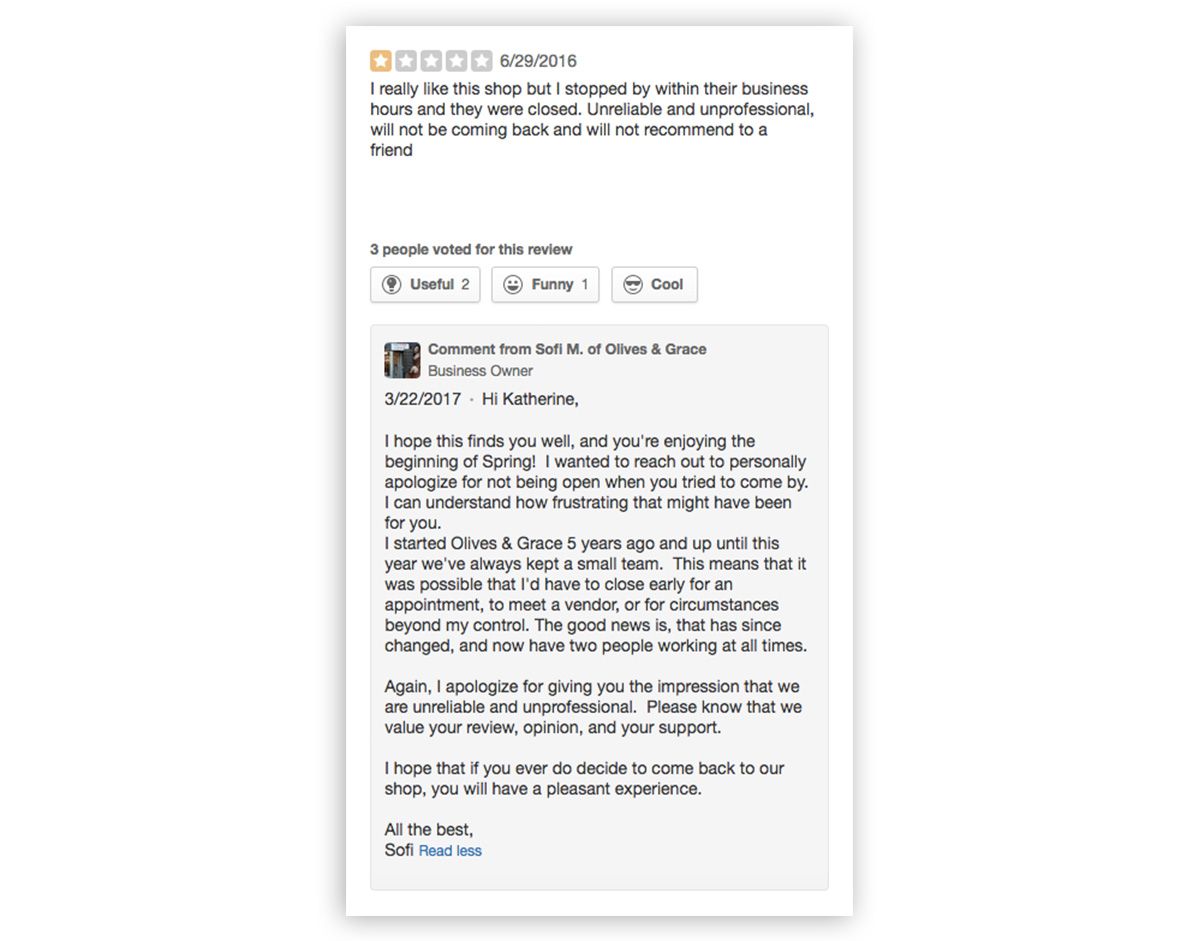97%.
That’s how many customers say online reviews factor into their buying decisions.
90% read online reviews before visiting a business.
88% trust these reviews to help them decide on their purchase. And
84% trust online reviews just as much as a personal recommendation.
Don’t have any reviews? 8% of customers don’t care.
The other 92%? They care quite a lot.
….I could go on. After all, I’m the first person to scour a restaurant’s Tripadvisor before booking a table, or scroll through user comments before investing in a new gadget. Aren’t we all?
These statistics are unsurprising today, when a company’s online reputation can be its greatest advantage — or its biggest liability. Even Apple aren’t immune to the power of the people.
Companies can try and convince users of the value of their product; but nothing carries as much weight as the words of people who aren’t paid to say them. Consumers trust other consumers more than they will ever trust us.
That’s why a word-of-mouth endorsement is the best form of marketing; but online reviews come a close second.
When we start a business, something that we’ve poured our heart and soul into is on the line for praise and criticism. Customer feedback can be wonderful. And it can be painful. Either way, it matters.
Good reviews are good news, naturally.
But the story doesn’t end there.
Each and every review is an opportunity for growth.
Yep, even the most awful ones.
They reflect what we do right, what we get wrong, and what our blind spots are.
And reviews are not the last word.
No matter how awesome our product, how thoughtful our customer service team, we can never achieve a completely clean slate with no negative feedback; in fact, it would actually be a little weird if we did.
We can’t control what people say about us, and we certainly shouldn’t delete bad reviews when they inevitably appear. What we can control is our response.
In fact, how we react to a review matters just as much as the review itself.
Because our response is a snapshot of something much bigger: our values, our service, our personality, our brand.
A snapshot visible to millions of people.
So, what kind of impression do we want to make?
First things first
Let’s face it: most responses to online reviews are pretty generic. That’s why the way in which we reply is a chance for us to stand out, and lend a human element to a static online interaction.
A warm, thoughtful response can have the same impact as a smile and a one-to-one conversation.
Of course, our level of formality will depend on the review. And of course, there isn’t a go-to method that works for everyone.
That being said, all responses will benefit from these pointers:
Name-calling
Addressing people by their name (whether it’s ‘Katie’ or ‘ilovewine2001’) and signing off with your own will strengthen the connection and make customers feel valued. In the case of a serious complaint, offer a way of continuing the conversation in private.
Thank you’s
Here’s something obvious (and yet often overlooked): thanking our customer for taking the time to share their thoughts. Full stop.
Keep it simple
Jargon, lofty mannerisms, convoluted sentences? Resist. They build barriers, and it’s hard to get a point across in overly-complex territory. It pays off to keep word choice simple and sentences short. Ask yourself: is this how I would speak to someone in real life?
Be specific
Repetition is boring. Automated replies are super-boring. Both are kind of offensive in this context. Copying and pasting the same reply says “this review is so unimportant to us that we couldn’t even be bothered to give you an individual response”.
Other things that will make your customer’s eyes glaze over: broad statements, abstractions, generalisations. Picking up on specifics shows a customer that they’ve been heard.
God is in the detail. Good customer service is too.
Bad reviews aren’t as bad as you think
Ouch. No matter who it comes from, negative feedback hurts. It’s hard not to take it personally.
Behind the keyboard, people are often more ruthless than they would be in real life.
That’s why negative online reviews are a triple whammy. They sting, they’re harsh — and they’re public.
Who wouldn’t want to defend themselves in this kind of situation? Many companies do.
Hint: it doesn’t work.
Being defensive will not just alienate the customer who wrote the critical review, but also all others reading it.
So where is the opportunity?
It’s a two-way conversation, remember. Your reply can change the customer’s mind — and everyone else’s in the process….
Changing minds
Make it genuine and gracious
“Fine. I’m ‘sorry’”, drawls the moody teenager, “But I want you to say sorry and MEAN IT,” replies the despairing parent.
That parent has a point. ‘We’re sorry for the inconvenience’ or ‘we apologize for the issue you had’ are the least sorry-sounding apologies ever. They say:
“We’re sorry that YOU had a problem (a problem for which we accept zero accountability, by the way) ”. They are the verbal equivalent of sticking your head in the sand. Not a good strategy. The alternative?
Take full responsibility. Let your apology reflect that you a) accept the issue b) will resolve it and c) will ensure it doesn’t happen again.
A customer writing a negative review feels aggrieved and may sound adversarial. We want to change this. A reply that is genuinely warm and considerate will take the wind out of the angry customer’s sails.
Don’t leave it to the intern
Fetching coffees, fact-checking… there are plenty of tasks that should be passed down the ranks. Replying to negative reviews isn’t one of them.
An apology will carry more weight when it comes from a higher echelon. The involvement of a senior staff member shows that we take an issue seriously.
Many negative reviews arise from a confusion on the part of the customer rather than a mistake on the part of the company. No need to point the finger, though; just politely clarify the situation, and offer a solution.
Sometimes resolving the issue means offering something extra: a discount, a freebie, an invitation to come in and chat. This kind of response creates loyalty.
Or, the magic words: “How can we make it up to you?” Putting the ball in the dissatisfied customer’s court gives them the chance to become constructive.
Respond quickly — but not too quickly
This is a tricky one. Take too long to respond and the unhappy customer (plus anyone else who’s reading) may think we are trying to sweep the bad review under the carpet by ignoring them.
But if we are too hasty, our spur-of-the-moment response can be overly emotional — or factually incomplete.
So, before you respond, hit the pause button. Make sure you’ve got the full picture. Jot down your thoughts. This way, you can be sure your reply is accurate, considered and helpful to everyone involved.
Plus, bad reviews are good for business
Bad reviews…
- manage expectations, giving customers a realistic picture of what they can expect from our product.
- prove our positive reviews are real. If a business has only good reviews, something’s off…
- help us improve. Customers are telling us how to refine our product and communicate with them better.
- provide free business insights. Companies spend $1000s on market research — but this criticism costs nothing.
- equal more conversions. When browsing online, most customers actively seek out negative reviews over positive ones.
Good reviews need great responses
Most companies understand the need to react to negative reviews, if only to fight fires and limit damage. But many will neglect responding to positive reviews. These customers are already on our side, so why bother? Here’s why: you could turn fans into brand ambassadors.
Thanking customers who already love our business is a win-win tactic. They feel appreciated, which will strengthen their loyalty. We just get a free referral, so why not express our appreciation?
Creating superfans
A few suggestions.
- MATCH their tone of voice. If their style is informal, make yours relaxed too. If they are brisk, keep your reply succinct.
- INVEST time in replying to the longest, most enthusiastic reviews.
- GIVE inside knowledge. If you remember the interaction, mention the details.
- SHARE a personalized sign-off.
More is more
If someone can be bothered to write something awesome about us online, we can be pretty sure they will be saying nice things about us to their friends, too. And nothing we say about our brand is going to carry as much weight as what someone non-affiliated says for free.
Because great reviews = effective, free advertising. With so much noise online, reviews from real people tend to be much more warmly received than generic marketing. We can leverage the power of our best reviews by cross-promoting them or integrating them with our social media platforms. This is a powerful way to re-engage users and increase social conversion rates.
Google pulls data from external online review sites to create its search results; the more positive reviews we have over as many platforms as possible, the more effective our rankings, organic traffic and ads will be.
So, it’s not just about having great reviews — it’s about having lots of great reviews.
You can set up a personalised review form in a couple of minutes here. No fuss or coding required.
How to get the review engine whirring
SAY PLEASE. 70% of people will follow through with a review when asked. You can solicit a review in an email following a transaction, in a subtle pop-up, as part of a remarketing campaign, or in person. You can quickly add a feedback button to your site using Jotform’s free builder to make collecting targeted customer feedback quick and easy. Make sure the request is as unobtrusive as possible.
MAKE IT EASY. The harder it is to leave a review, the less likely people are to do it. With every extra step you add to the process, someone will decide they can’t be bothered to complete it. Having an option of simply clicking a star-rating and posting is a great place to start. Users should be encouraged, but not forced, to leave written feedback. If you have a review section on your website, make the process straightforward and the review button clearly visible. Oh, and make the process mobile-friendly, so that users can write reviews on the go.
SAY THANKS. A review is a favour. Many businesses offer incentives to encourage reviewing, reward loyal customers and drive growth. These take many forms, from a simple promo code to the chance to win a prize in exchange for a review.















Send Comment:
5 Comments:
More than a year ago
One of the best, if not the best article I have read about this topic. Thank you for creating it. Hope you guys have this on Medium, because I would be all over it! (I found this site thru Medium).
Additionally, the level of detail in the article was excellent, deep, well concocted. Loved it!
Reading it gave me several ideas and strengthened further things I knew. Thanks again!
More than a year ago
The links in these two lines are mixed up, you should reverse them:
- The "here" in "You can set up a personalised review form in a couple of minutes here. No fuss or coding required."
- The "70%" in "SAY PLEASE. 70% of people will follow through with a review when asked."
More than a year ago
I looked at tons of form blog and reviews and was very intrigued by JotForms!
More than a year ago
Ha, I agree, princess. This post and the one from January 2 are pretty rich coming from jotform right now.
More than a year ago
a follow up blog should be about:
how to inadvertently turn your fans and ambassadors into haters.
that's what jotform did to me ?